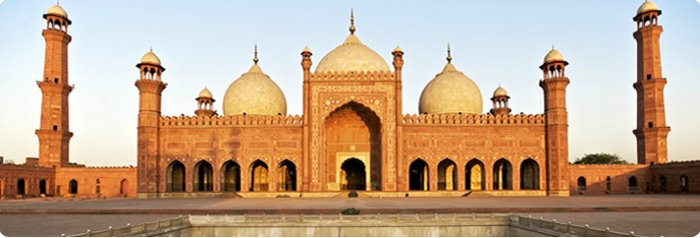
The Badshahi Mosque in Lahore was commissioned by the sixth Mughal Emperor Aurangzeb. Constructed between 1671 and 1673, it was the largest mosque in the world upon construction. It is the second largest mosque in Pakistan and the fifth largest mosque in the world.
It is Lahore's most iconic and famous landmark and a major tourist attraction. Aurangzeb's mosque's architectural plan is similar to that of his father, Shah Jehan, the Jama Masjid in Delhi; though it is much larger. it also functions as an idgah. The courtyard which spreads over 276,000 square feet, can accommodate one hundred thousand worshippers; ten thousand can be accommodated inside the mosque. The minarets are 196 feet (60 m) tall. The Mosque is one of the most famous Mughal structures, but suffered greatly under the reign of Maharaja Ranjit Singh. In 1993, the Government of Pakistan included the Badshahi Mosque in the tentative list for UNESCO World Heritage Site.
The mosque is located in the Walled City of Lahore, Pakistan, just opposite to the Alamgiri Gate of the Lahore Fort. The Hazuri Bagh separates the mosque and the fort. On the Eastern side of the garden is one of the thirteen gates of Lahore, The Roshnai Gate.[3] TheTomb of Muhammad Iqbal lies beside the mosque.
The mosque was constructed by the sixth Mughal emperor Aurangzeb, who, unlike the previous emperors, was not a patron of art and architecture. He built the mosque between 1671 and 1673 under the guidance of Fidai Khan Koka, his "master of ordinance".
On 7 July 1799, the Sikh army of the Sukerchakia chief, Ranjit Singh, took control of Lahore. After the capture of the city, the Badshahi mosque was desecrated by Ranjit Singh, who used its vast courtyard as a stable for his army horses, and its 80 hujras (small study rooms surrounding the courtyard) as quarters for his soldiers and as magazines for military stores. Ranjit Singh used the Hazuri Bagh, the enclosed garden next to it, as his official royal court of audience. In 1818, he built a marble edifice in the garden facing the mosque.
In 1841, during the First Anglo-Sikh War, Ranjit Singh's son, Sher Singh, used the mosque's large minarets for placement of zamburahsor light guns. It was used to bombard the supporters of Chand Kaur taking refuge in the besieged Lahore Fort, inflicting great damage to the fort itself. In one of these bombardments, the fort's Diwan-e-Aam (Hall of Public Audience) was destroyed (it was subsequently rebuilt by the British but it could not be exactly restored in the previous state). During this time, Henri De la Rouche, a French cavalry officer employed in the army of Sher Singh, used a tunnel connecting the Badshahi mosque to the Lahore fort to temporarily store gunpowder.
In 1849 during the British Raj, the British continued using the mosque and the adjoining fort as a military garrison. The 80 cells (hujras) built into the walls surrounding the its vast courtyard on three sides were originally study rooms, which were used by the Sikhs under Ranjit Singh to house troops and military stores. The British demolished them so as to prevent them from being used for anti-British activities and rebuilt them to form open arcades or dalans.
Because of increasing Muslim resentment against the use of the mosque as a military garrison, the British set up the Badshahi Mosque Authority in 1852 to oversee the restoration and to re-establish it as a place of religious worship. From then onwards, piecemeal repairs were carried out under the supervision of the Badshahi Mosque Authority. Extensive repairs commenced from 1939 onwards, when Sikandar Hayat Khan took on the task of raising funds for this purpose.
It was not until 1852 that the British established the Badshahi Mosque Authority to oversee the restoration of the mosque as a place of worship. Although repairs were carried out, it was not until 1939 that extensive repairs began, supervised by the architect Nawab Zen Yar Jang Bahadur. The repairs continued until 1960 and were completed at a cost of 4.8 million rupees.
On the occasion of the 2nd Islamic Summit held at Lahore on 22 February 1974, thirty-nine heads of Muslim states offered their Friday prayers in the Badshahi Mosque, including, among others, Zulfiqar Ali Bhutto of Pakistan, Faisal of Saudi Arabia, Muammar Gaddafi of Libya,Yasser Arafat of the Palestine Liberation Organization and Sabah III Al-Salim Al-Sabah of Kuwait. The prayers were led by Mawlānā Abdul Qadir Azad, the then khatib of the mosque.
Between 1939 and 1960, the mosque was repaired to bring it back to its original condition. In 1993, the Government of Pakistan included the Badshahi Mosque in the tentative list for UNESCO World Heritage Site.
In 2000, the marble inlay in the main prayer hall was repaired. In 2008, replacement work on the red sandstone tiles on the mosque's large courtyard commenced, using red sandstone especially imported from the original source near Jaipur, India, bringing it to be nearly restored.
